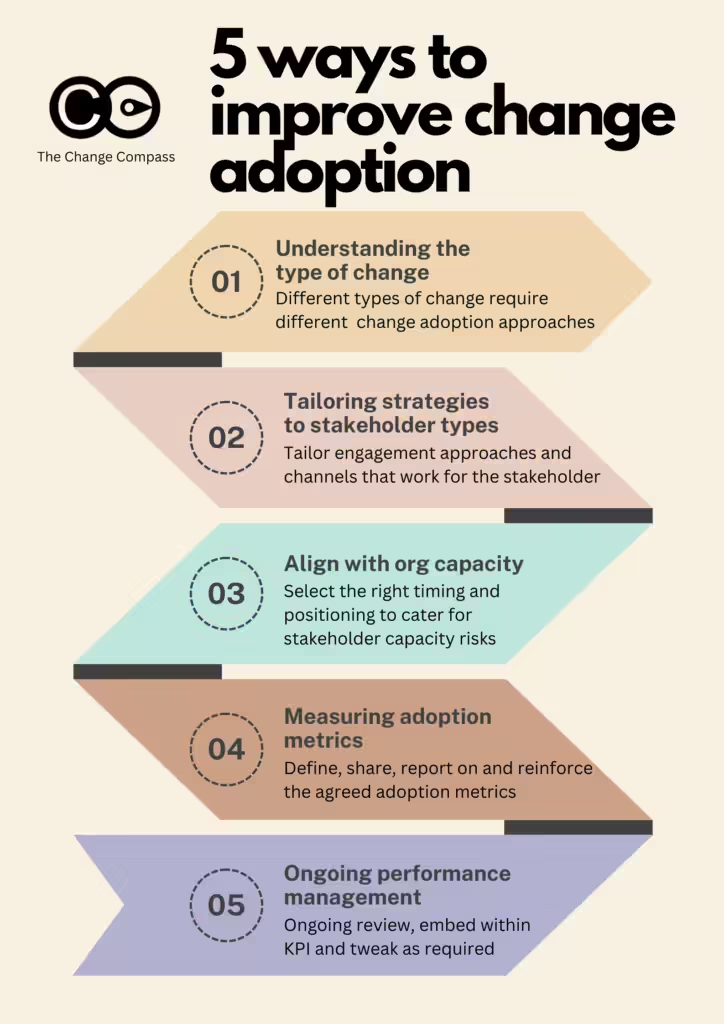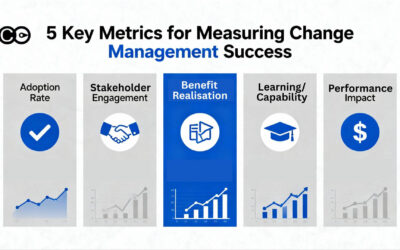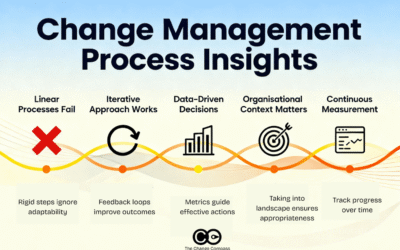Change adoption is the heart of every change practitioner’s work. It’s the primary measure of whether a change initiative truly succeeds, yet, surprisingly, many organizations still fail to adequately track, measure, and manage change adoption. Without a clear understanding of how well end-users are adopting the change, it’s nearly impossible to gauge the initiative’s real impact on the business. Change adoption must be both intentional and managed, not just assumed.
If you search for change adoption on Google the top articles seem to refer to the same things. These include transition preparation, communication, training and support. The top 2 articles are by Whatif and Walkme and seem to emphasise the importance of in-app training products they offer. The Prosci article emphasise the ADKAR model on the other hand.
While common strategies for change adoption—such as communication, training, and support—are essential, these are foundational steps and not the complete formula for sustained adoption. There’s a nuanced spectrum of factors that contribute to adoption, including the type of change, the stakeholders, the organization’s capacity for change, measurement metrics, and performance management. The following insights explore these core factors and share practical strategies, bolstered by real-world examples, to help change practitioners improve adoption rates across their organizations.
1. Understanding the Type of Change
The nature of the change plays a significant role in determining how to drive adoption. A change can range from a simple update in process to a fundamental shift in behaviour, and this range requires different approaches:
– Simple Changes : Minor changes, like a new software feature or a small process tweak, may only need a basic communication update. For instance, consider an HR team implementing a new self-service portal for employees to access their pay stubs. In this case, a simple email announcement explaining how to access the feature, along with a short tutorial video, might be all that’s required to ensure adoption.
– Complex, Behavioural Changes : For more complex changes that impact behaviours or workflows, adoption strategies need to be more involved. Imagine an organization implementing a new performance review system that shifts from annual reviews to ongoing, quarterly feedback sessions. This type of change isn’t just procedural—it demands a shift in how employees and managers think about performance. Here, communication alone won’t be sufficient. It requires ongoing training, leadership modeling, reinforcement through feedback loops, and alignment with performance metrics. Regular team meetings can serve as a platform for leaders to showcase the change, while role-playing sessions can help embed the new behaviours.
Analogy : Think of the change type as similar to cooking different dishes. For a quick salad, all you need is the right ingredients and a bowl to toss them in. For a complex dish like a soufflé, you’ll need precise measurements, specific tools, and careful monitoring to ensure it doesn’t collapse. The type of change similarly determines the level of preparation and intervention required.
2. Tailoring Strategies to Stakeholder Types
Understanding your end-users or stakeholders—those directly impacted by the change—is crucial. Each group will have different engagement channels and needs, which means you can’t rely on a one-size-fits-all communication plan. To drive adoption, you need to deliver information in ways that resonate with each audience.
– Identify Effective Channels : For example, one team may prefer to discuss updates in weekly meetings, while another may respond better to monthly town hall sessions. When a global retail company rolled out a new inventory management system, the change team customized its communication and training by region. Regional managers were empowered to communicate the changes in a way that suited their teams’ preferences, whether that meant team huddles, newsletters, or one-on-one conversations. As a result, the change was embraced much more readily because each team felt that the approach was tailored to their needs.
– Build Change into Routine Communication : To make the change part of the team’s daily workflow, leverage existing channels, like monthly business reviews or quarterly updates. For instance, if sales teams have weekly performance meetings, consider incorporating brief updates about how the change (such as a new CRM feature) can benefit their sales process, along with success stories from team members.
Analogy : Think of stakeholder engagement as similar to hosting a dinner party. You wouldn’t serve the same meal to every guest without considering their preferences. Similarly, change practitioners need to “serve” the change in ways that appeal to each stakeholder group’s tastes and communication preferences.

3. Aligning with Organisational Change Capacity
Change capacity—the organization’s ability to absorb and adopt change—is a critical but often overlooked factor. The timing of introducing new changes matters, especially when the change is complex. If an organization is already handling multiple projects or transformations, adding another initiative can result in resistance or “change fatigue.”
– Manage Competing Priorities : Suppose a financial services company is simultaneously upgrading its internal software, launching a new customer-facing app, and implementing a data security compliance initiative. Launching yet another change, like a new employee recognition program, may overwhelm employees, who may deprioritize it in favour of what they perceive as more urgent projects. Change practitioners should work closely with program managers to prioritize initiatives and strategically phase them to avoid saturation.
– Change Portfolio Management : Treat change initiatives as part of a portfolio. By actively managing this portfolio, you can ensure changes are introduced in waves that the organization can absorb. Regularly review the status of active changes with stakeholders to reassess the capacity and timing. This way, your adoption efforts won’t be diluted by other competing projects.
Analogy : Imagine trying to load groceries into an already-full refrigerator. Some items will fit, but others might have to wait. The same concept applies to organizational change capacity—only so much can fit into the organization’s “refrigerator” at once before things start falling out.
4. Defining and Measuring Adoption Metrics
Effective change adoption strategies hinge on clear metrics. Without defined adoption goals and measurement tools, it’s difficult to determine if users are actually embracing the change or merely checking boxes. Metrics will vary depending on the change and should be relevant to the behaviours or outcomes desired.
– Set Clear Adoption Metrics : For example, a company introducing a new collaborative software might measure adoption through the frequency of use, the number of shared documents, or the volume of cross-departmental activity within the platform. Each of these metrics helps track actual usage and determine if employees are using the tool to its full potential.
– Gauge Awareness, Willingness, and Competency : Assess and understand stakeholder readiness for the change at hand. Do they have the awareness, motivation and know-how for the new expected behaviours? Conduct regular surveys or feedback sessions to assess where teams are on the adoption curve. This approach can highlight areas where additional support is needed, such as more coaching or stronger reinforcement from leadership.
Analogy : Think of adoption metrics like the gauges in a car’s dashboard. Each gauge (speed, fuel, engine temperature) provides specific insights into the car’s overall performance, just as adoption metrics give insights into how well a change is taking hold within the organization.
5. Ongoing Performance Management for Sustained Adoption
Adoption isn’t a “one and done” effort. It requires continuous management, monitoring, and, ideally, integration into performance management. By tracking and reinforcing adoption metrics over time, organizations can keep the change front and centre and drive deeper, lasting adoption.
– Incorporate Adoption into KPIs : Align adoption goals with KPIs to maintain visibility. For example, if the goal is to increase the use of a project management tool, set a KPI that tracks project updates within the tool. Managers can be held accountable for meeting this KPI, incentivizing their teams to incorporate the tool into their workflow.
– Regular Check-Ins and Feedback: Use data-driven insights to adjust your strategy as needed. For instance, if certain teams lag in adoption rates, consider arranging tailored training sessions or conducting one-on-one interviews to understand the barriers they’re experiencing. Continuous feedback loops allow change practitioners to refine their approach based on real-time adoption data. Performance needs to be constantly nurtured, reinforced and managed. No ‘set and forget’ approach will work.
Analogy: Sustaining adoption is like maintaining a healthy habit. Just as regular exercise requires motivation, tracking, and routine check-ins to stay consistent, ongoing performance management helps ensure that change remains a part of the organizational fabric.

Data as the Catalyst for Improved Change Adoption
Data-driven insights are game-changers for change adoption. They enable change practitioners to move beyond guesswork and implement strategies with measurable, predictable results. By leveraging analytics, organizations can identify successful tactics based on stakeholder type, change type, and historical adoption patterns.
For example, by analyzing adoption data from previous projects, a technology company could discover that smaller, incremental training sessions worked better for developers than day-long sessions. This insight could inform future adoption strategies and improve the likelihood of success for similar changes.
Utilizing data to understand what drives adoption allows change practitioners to apply these learnings across the organization, achieving more consistent and reliable outcomes. Through correlation and prediction, organizations can anticipate which approaches will work best for each type of change and tailor their strategies accordingly.
This is exactly what we’ve been doing at The Change Compass. We’ve incorporated automation and AI to provide data insights that tell you what tactics and approaches work to maximise change adoption based on data. You can also drill into what works for particular stakeholders, business units and types of changes. Data insights can also inform what volume of change may stifle change adoption.
Designing change approach and interventions should not be guess work. So far, companies try to enhance their rates of change adoption success by hiring change management specialists, together with stakeholder feedback. However, the most senior stakeholder or those with the loudest voice in the room don’t always get the outcome. These are still based on opinions, versus what has proven to work based on data. Imagine the power of implementing this across the enterprise and the ability to avoid costly mistakes and mishaps in the tens (or hundreds) of millions of investments in change initiatives per annum.

Building a Culture of Adoption
Improving change adoption is not a one-time effort but an ongoing, intentional process that combines targeted communication, stakeholder engagement, capacity planning, performance tracking, and data-driven insights. By focusing on the unique aspects of each change, tailoring strategies to specific stakeholder groups, and continuously managing performance, change practitioners can significantly increase adoption rates. Ultimately, success lies in building a culture where change is not just accepted but actively integrated into the organization’s DNA.
When change adoption becomes a measurable, manageable, and data-driven process, practitioners can guide their organizations through change with confidence and clarity, transforming resistance into resilience and integration into innovation.
For more about change adoption, check our our guide ‘How to measure change adoption‘.
Chat to us to find out more about how you can leverage a digital approach to hit your change and transformation goals at scale.






